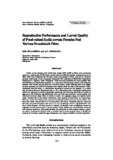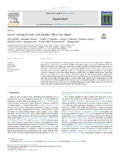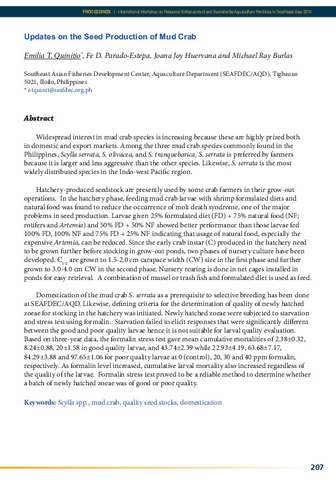Reproductive performance and larval quality of pond-raised Scylla serrata females fed various broodstock diets
Share
Abstract
Scylla serrata females with initial body weight (BW) of 350 to 400 g were previously raised on a defined diet of 75% brown mussel meat and 25% fish bycatch in grow-out ponds at Molo, Iloilo City, Philippines for 120 days. Crabs were stocked in three units of 4 m diameter concrete indoor tanks at the Crustacean Broodstock Wet Laboratory of SEAFDEC Aquaculture Department in Tigbauan, Iloilo, Philippines. Tanks had sand substrates and were supplied with sand-filtered and chlorinated seawater in a continuous flow-through system with adequate aeration. Each female was provided with individual shelter. Before stocking, crabs were tagged on their carapace and half of the females were ablated while the other half remained intact. Broodstock were fed either T1, natural food consisting of mussel and fish bycatch; T2, a mixed diet of natural food and formulated diet; or T3, a formulated diet. Broodstock reproductive ability was measured as percent spawnings, spawnings with hatching, fecundity or number of eggs per g BW of female, egg fertilization rate and total zoea produced. Larval quality was measured as larval stage index or ability to attain the megalopa stage, the highest larval stage. Females fed on all dietary treatments were capable of maturation and spawnings. However, mixed diet feeding (T2) improved broodstock performance and larval quality over those fed either natural food (T1) or formulated (T3) alone. Eyestalk ablation improved fecundity and produced higher total zoea in T1 and T3 although lower in egg fertilization rate than intact females. All zoea larvae in ablated T2 females were successfully reared to megalops. Overall improvement in larval quality of both ablated and intact females compared with previous studies on wild-caught females was attributed to their dietary history in grow-out ponds. Feeding the females with a suitable diet in ponds enabled them to fortify the reserves of nutrients needed for egg development and improve stability in larval production.
Suggested Citation
Millamena, O. M., & Bangcaya, J. B. (2001). Reproductive performance and larval quality of pond-raised Scylla serrata females fed various broodstock diets. Asian Fisheries Science , 14(2), 153-159. http://hdl.handle.net/10862/1906
Subject
Taxonomic term
Collections
- AQD Journal Articles [1249]
Related items
Showing items related by title, author, creator and subject.
-
Larval rearing of mud crab (Scylla): What lies ahead
Waiho, Khor; Fazhan, Hanafiah; Quinitio, Emilia T.; Baylon, Juliana C.; Fujaya, Yushinta; Azmie, Ghazali; Wu, Qingyang; Shi, Xi; Ikhwanuddin, Mhd; Ma, Hongyu (Elsevier, 2018)The increasing global demand for mud crabs (genus Scylla) and threats to the wild populations highlight the urgency of fully rearing them in captivity. Despite considerable progress in mud crab production, most crab farms ... -
Mud crab pond and pen culture
Rodriguez, Eduard M. (University of the Philippines Aquaculture Society, Inc, 2001) -
Updates on the seed production of mud crab
Quinitio, Emilia T.; Parado-Estepa, Fe D.; Huervana, Joana Joy; Burlas, Michael Ray (Aquaculture Department, Southeast Asian Fisheries Development Center, 2015)Widespread interest in mud crab species is increasing because these are highly prized both in domestic and export markets. Among the three mud crab species commonly found in the Philippines, Scylla serrata, S. olivacea, ...




